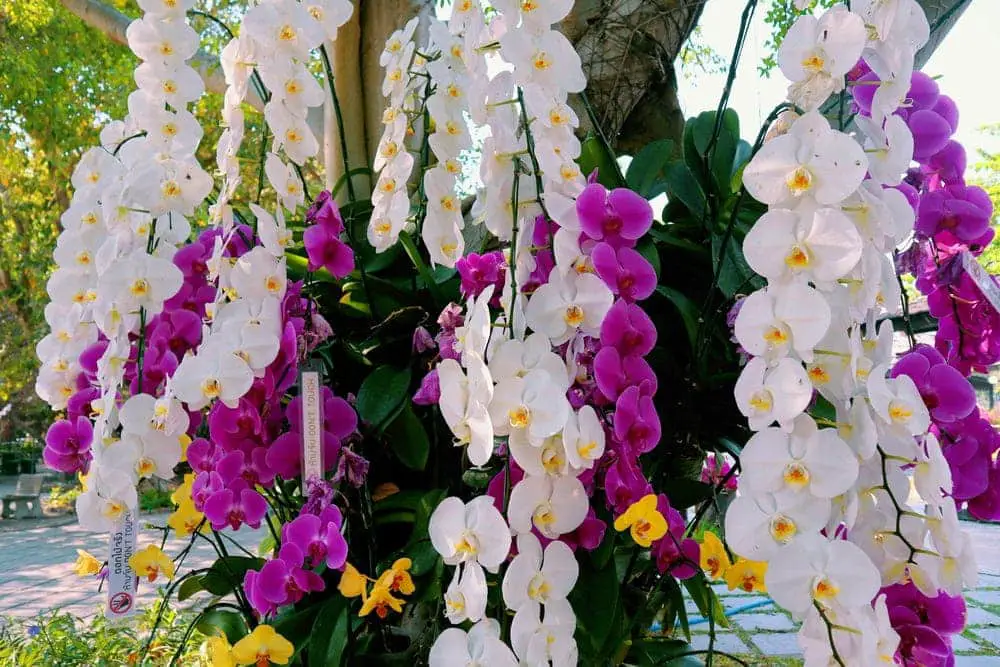Orchids have a bad reputation of being hard to care for properly and there are some varieties of orchids that are difficult to grow.
Before you purchase one, make sure that it is easy to maintain and grow. Here are some tips to help you grow beautiful orchids.
Orchids Care and Growing Guide
1. About Orchid
Many orchids are considered epiphytes, which mean that they grow on trees naturally. They can be available also in nurseries. They are an air plant. They use photosynthesis to produce their own energy.
They get their nutrients and water from the rain, organic debris, and dust that accumulate around them, and the air. According to the World Checklist of Selected Plant Families, there are approximately 26,570 species of orchids. They do look like a delicate flower but as with all plants, they need three things to survive; soil, water, and sunlight.
2. Light Requirement
The best spot for your orchids would be on a windowsill in a window that is east-facing. They can sit in an unscreened south-facing window if you use a sheer curtain that will filter out the bright hot light. So it is not in constant strong indirect light, you should set the orchid back from the window a few feet.
It is generally too hot for orchids if you put them in west-facing windows but sometimes you can make them work if you use sheer curtains to filter the light. A north-facing window is generally to dim for them.
3. Water
Over-watering your orchids is the number one reason that they, and most other houseplants, die. Instead of having a strict schedule of when to water, such as every week or two weeks, pay attention to your orchids’ needs. Know how much water they do use. And it is not a set amount but varies based on light, humidity, potting mix it is growing in, and air movement. You should water your orchids just before they go dry.
To tell if it is time to water your orchids, stick your finger in the potting mix, and when you pull it out rub your fingers together. You should be able to tell if there is any moisture and if there is none, then it is time to water your orchids.
If your fingers are moist, then wait a couple of more days before you try again. To water your orchids, just pour water in the potting mix and let it run out the drain holes at the bottom.
4. Humidity
Yes, most orchids are tropical plants but they do not need rain forest humidity. You do not need the dry atmosphere a home has with air-conditioning. If you do have that type of environment, you will need to put your orchids on a tray of gravel that is half covered with water so that when it evaporates it puts humidity in the air or you need to mist it daily.

5. Temperatures
Make sure that your orchids are not exposed to abrupt temperature changes or drafts because they suffer when the temperatures drop below 50 degrees Fahrenheit. Most orchids cannot tolerate freezing temperatures. Do not leave them near a cold window at night.
6. Soil
Orchids are generally potted in bark chips or sphagnum moss. Do not use regular potting soil as it can suffocate the roots and kill the plants. You can also use a special potting mix for orchids.
Sphagnum moss: This acts as a sponge and soaks up the water. It will take a long time to dry out. Since it holds onto moisture you will be able to wait a little longer between watering. The drawback is that with sphagnum moss it is not as forgiving if you over-water it.
Bark chips: This potting mix does not hold much water and it drains out quickly. This is a good choice for the orchids that have to dry out between watering.
7. Fertilizer
It is recommended that you use 20-20-20 with little to no urea. You can also fertilize your orchids each time you water. Just use one-fourth of the recommended amount of the water-based fertilizer on the label. Before you fertilize your orchids, make sure that the potting mix is a little damp. If the orchids are completely dry, it can burn the roots.
Also read: String of Turtles: Plant Care & Growing Guide
8. Repotting
You will generally have to repot your orchids every year or so because eventually the potting material will start to decompose. This is especially true about bark. When the bark potting mix starts to decompose, it will not drain as well. It seems that bark, more than sphagnum moss, decomposes more often and quicker.
When repotting, remove the plant from the old bark and clip off any dead roots you might notice; they are the ones that are shriveled and dark. After you wipe out the planter you can put in the orchid plant and refill it with bark chips. When you do repot your orchids use ceramic or plastic containers. You should repot after it has finished flowering.
9. Flowering
They bloom once a year and continue to bloom for a month. You can trick the orchid to bloom again towards the end of the bloom cycle by pruning the flower portion of the plant. Just take it away at the node right below the first flower
Similar post: Aloe Vera: Plant Care and Growing Guide
Are Orchids Poisonous?
Orchids are not poisonous to children or pets.
Learn more: Cat’s Claw Plant Care
Conclusion
Yes, orchids do have a different need when you compare them to other plants but all you have to do is master the basics of care and soon you can raise orchids as a houseplant. They are a unique plant so you can display them in fun ways like from a hanging basket. Start out with a simple orchid, such as the moth orchid.
Find an orchid that is easy to take care of before you move up to the next species that is a bit harder to grow. They are a beautiful, delicate flower that can be combined with other orchids and other species of flowers to make beautiful arrangements. Learn about the orchids you want before you purchase them so you know how to grow the species you chose.
More like this:
- Macho Fern Care & Growing Guide
- Dragon’s Tongue Plant Care & Growing Guide
- Winter Rose Poinsettia: Plant Care & Growing Guide
Victoria is the owner and main author of hobby plants. She loves spending her free time in her garden planting and taking care of her plants. Victoria hopes you enjoy the content here!




![Mother Of Thousands Plant [Complete Plant Care Guide] Mother Of Thousands Plant [Complete Plant Care Guide]](https://www.hobbyplants.com/wp-content/uploads/2022/07/mother-of-thousands-plant-300x158.jpg)
![Majesty Palm Plant Care: [Complete Beginner's Guide] Majesty Palm Plant Care: [Complete Beginner's Guide]](https://www.hobbyplants.com/wp-content/uploads/2022/08/majesty-palm-care-300x158.jpg)
![Exotic Angel Plant Care: [Complete Beginner's Guide] Exotic Angel Plant Care: [Complete Beginner's Guide]](https://www.hobbyplants.com/wp-content/uploads/2022/08/exotic-angel-plant-care-300x158.jpg)
![Snow White Waffle Plant: [Complete Care Guide] Snow White Waffle Plant: [Complete Care Guide]](https://www.hobbyplants.com/wp-content/uploads/2022/08/snow-white-waffle-plant-300x158.jpg)
![Waffle Plant Care: [Complete Beginner's Guide] Waffle Plant Care: [Complete Beginner's Guide]](https://www.hobbyplants.com/wp-content/uploads/2022/08/waffle-plant-300x158.jpg)
![Bird Of Paradise Plant Care: [Complete Beginner's Guide] Bird Of Paradise Plant Care: [Complete Beginner's Guide]](https://www.hobbyplants.com/wp-content/uploads/2022/08/bird-of-paradise-plant-300x158.jpg)
![Purple Passion Plant Care: [Complete Beginner's Guide] Purple Passion Plant Care: [Complete Beginner's Guide]](https://www.hobbyplants.com/wp-content/uploads/2022/08/purple-passion-plant-care-300x158.jpg)
![China Doll Plant Care: [Complete Beginner's Guide] China Doll Plant Care: [Complete Beginner's Guide]](https://www.hobbyplants.com/wp-content/uploads/2022/09/china-doll-plant-care-300x158.jpg)